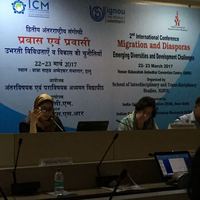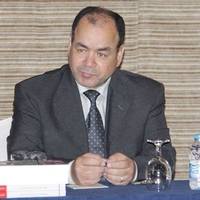
Binish Qadri
After completing her matriculation from Presentation Convent Higher Secondary
School, Rajhbagh, Srinagar with distinction (85%) she opted for Arts stream in which she excelled with IST position (91%) in 12th board exams in J&K state for which she was awarded a memento of honor by Jammu and Kashmir Board of School Education (JKBOSE) and a Gold Medal. Her interest in humanities made her join Womens college M.A. road, Srinagar where she completed her graduation with distinction. Since she comes from a business family her taste for economics was right from her 8th standard which added flavors with every passing day and finally made her mind for masters in Economics from Kashmir University. Moreover, she qualified N.E.T and S.E.T as well. Teaching has always been her love and passion which she started as early as 18. Her search for new ideas made her develop a liking for research which culminated in joining an integrated M.Phil. /Ph.D. program in Economics in March 2016 from Central University of Kashmir.
She did her M.Phil. on Problems and Prospects of Saffron Marketing in Kashmir Valley and Ph. D on the economic analysis of the Saffron economy in Jammu and Kashmir. In addition, she has participated and presented research papers in many national and international conferences of high repute. She has in her credit more than a dozen national and international publications. Her hard work and passion for research helped her in acquiring the position of editor and reviewer in many reputed national and international journals. Furthermore, she won many awards in her academic and research career for her M.Phil. Dissertation. In addition, she is awarded reputed ICSSR Full-Term Centrally-Administered Doctoral Fellowship for her Ph.D. work for the Year 2018-19 which she completed in march 2021. In addition, she was a guest faculty in National Institute of Fashion Technology, Srinagar with the task of teaching Communications to undergraduate students. After completion of her Ph.D she joined Kashmir university as a contractual lecturer and then Cluster university for the last two years.
Supervisors: Professor G.M.Bhat
Address: Namblabal Pampore, near government girls higher secondary school, Srinagar, Kashmir
School, Rajhbagh, Srinagar with distinction (85%) she opted for Arts stream in which she excelled with IST position (91%) in 12th board exams in J&K state for which she was awarded a memento of honor by Jammu and Kashmir Board of School Education (JKBOSE) and a Gold Medal. Her interest in humanities made her join Womens college M.A. road, Srinagar where she completed her graduation with distinction. Since she comes from a business family her taste for economics was right from her 8th standard which added flavors with every passing day and finally made her mind for masters in Economics from Kashmir University. Moreover, she qualified N.E.T and S.E.T as well. Teaching has always been her love and passion which she started as early as 18. Her search for new ideas made her develop a liking for research which culminated in joining an integrated M.Phil. /Ph.D. program in Economics in March 2016 from Central University of Kashmir.
She did her M.Phil. on Problems and Prospects of Saffron Marketing in Kashmir Valley and Ph. D on the economic analysis of the Saffron economy in Jammu and Kashmir. In addition, she has participated and presented research papers in many national and international conferences of high repute. She has in her credit more than a dozen national and international publications. Her hard work and passion for research helped her in acquiring the position of editor and reviewer in many reputed national and international journals. Furthermore, she won many awards in her academic and research career for her M.Phil. Dissertation. In addition, she is awarded reputed ICSSR Full-Term Centrally-Administered Doctoral Fellowship for her Ph.D. work for the Year 2018-19 which she completed in march 2021. In addition, she was a guest faculty in National Institute of Fashion Technology, Srinagar with the task of teaching Communications to undergraduate students. After completion of her Ph.D she joined Kashmir university as a contractual lecturer and then Cluster university for the last two years.
Supervisors: Professor G.M.Bhat
Address: Namblabal Pampore, near government girls higher secondary school, Srinagar, Kashmir
less
Related Authors
Lisebo A Tseane-Gumbi
North West University Mafikeng Campus
Matt Sparke
University of California, Santa Cruz
USMAN RIAZ MIR
University of Management and Technology
Dr. Antar A. AbouKorin
Minia University
Aslam Bhat
Kashmir
Agis Digkas
National and Kapodistrian University of Athens









Uploads
Conference Presentations by Binish Qadri
SHGs have positively and effectively developed the utilization and management of economizing and
credit needs, uphold linkages and associations with the banks and put into effect monetary and fiscal
willpower (APMAS, 2003). However, in the contemporary times, self-help groups are not working up
to their capacity and therefore, their role and significance in Growth and Development prospects of
the country in general and agriculture sector, in particular, remain largely invisible. The present paper
argues that self-help groups have multiplied in quantity but not in quality and therefore scrutinizes
collaborating and reactionary elements in SHG’s.
The present study adopted a Mixed Sampling Method for the selection of respondents. Out of
10 districts of Kashmir Valley district, Budgam and Ganderbal were randomly selected. From each
district, a block with the highest rural population was selected purposively. Out of each block, a sample
of 30 was randomly selected, making a total sample size for the study 60.
To analyze the impact of a few selected variables namely total savings, nature, irregularity towards
group savings and a number of beneficiaries on the participation of SHGs in income generation activities,
the present study employed binary logistic regression. In this study, participation in income generation
activities by SHGs has been considered as the dependent variable (defined as 0 if not participates
in income generation activities and defined as 1 if participates in income generation activities). The
following logit model was estimated and binary logistic regression was run: P (Participation in income
generation activities) = 1│x) = Log [Pi/(1-Pi)] = β0 + β1 total savings+ β2 nature+ β3 irregularity
towards savings+ β5 number of beneficiaries+ ε.
Where, y is a binary variable i.e. y = Participation in income generation activities = 0 if not
participates in income generation activities, = 1 otherwise.
236
60th Labour Economics Conference
X1 = total yearly savings (continuous).
X2 = nature of a SHG (dummy) = 1 if a group is registered or 0 otherwise.
X\3 = Irregularity towards group savings (dummy) = 0 if there is frequent irregularity towards
group savings or otherwise.
X4 = number of beneficiaries of a SGH per year (continuous).
From the obtained data and statistical analysis, we concluded that the decision of SHGs to
participate in income generation activities is greatly influenced by their amount of savings, nature,
and irregularities in their savings, and number of beneficiaries. Those SHGs who do not participate
in income generation activities face problems of minimal savings, irregularities in savings, are usually
unregistered and show a dismal performance in a number of their beneficiaries. This non-participation
in income generation activities mars their overall efficiency because participation in income generation
deeds has their significance in achieving group goals and thereby, increases the level of group efficiency
and work quality. So SHGs should pay specific attention towards increasing their group savings,
maintaining regularity in their savings and should pay attention towards their registration process, and
by doing this, they can address the problems of their declining efficiency and quality. SHGs should
remember that they have to grow their business on their own and their regular participation in income
generation activities is one of the best ways to carry forward this noble cause.
saffron mission is likely to boost the overall saffron production of Kashmir from 15MT to 22MT. (Souvenir Saffron Exporters Brand, 2016). An expansion program in non-traditional areas will further enhance the overall production to about 60MT. Therefore, there is a need to provide the solution to the farmers for the better market which at present is
unorganized. Improving the marketing value chain of saffron with structured marketing channels will definitely increase livelihood security of more than 16000 farm families which are associated with this trade directly or indirectly. The present study is, therefore, an attempt to highlight the problems of marketing of saffron in Kashmir valley so as to
provide remedial measures and benefit the growers as much as possible and encourage their involvement in the saffron value chain.
is tourism but, unfortunately, this sector absorbs unorganized and unskilled workers, too, so that educational unemployment is peaked and superceding all barriers. Moreover, the state has a decent
literacy rate of 68per cent, with over 6 lakh educated unemployed youth. The major chunk of educated youth is engaged in the government sector, which is the main source of employment here. In Jammu and
Kashmir’s economy, the public sector is dominant engaging almost 80per cent of educated youth. Put alternatively, a strong public sector is responsible for the high rate of educated unemployment
and it is our endeavour, through this paper, to highlight the main weaknesses of the state economy responsible for chronic educated unemployment. In addition, the present paper will focus on new
innovative schemes on the part of the state government to overhaul the existing economic system, where the schemes envision to use the efficient human resource for gainful productive employment.
Educated unemployed youth, from frustration resort to negative criminal activities. So, by curbing educated unemployment, the state will have a trickle-down effect, and will also restore peace on the political front as well. Development is not possible without peace. The present paper will also focus on the industrial sector of the state of Jammu and Kashmir, both small as well as large scale, and its potential to control educated unemployment. The state has one of the poorest domestic structures
for establishing a strong industrial base. The turmoil in the state involving civil and political issues, lack of electricity, lack of effective human resource and poor road connectivity are some of the essential
factors that are hampering industrial set up. Through this paper, we will explore the potential of this sector to control educated unemployment, and suggest measures and policies on the part of state government establish the strong industrial base. Moreover, the paper will examine the major
causes for the failure of state and centrally sponsored schemes to eradicate unemployment in the
state of Jammu and Kashmir.
Papers by Binish Qadri
SHGs have positively and effectively developed the utilization and management of economizing and
credit needs, uphold linkages and associations with the banks and put into effect monetary and fiscal
willpower (APMAS, 2003). However, in the contemporary times, self-help groups are not working up
to their capacity and therefore, their role and significance in Growth and Development prospects of
the country in general and agriculture sector, in particular, remain largely invisible. The present paper
argues that self-help groups have multiplied in quantity but not in quality and therefore scrutinizes
collaborating and reactionary elements in SHG’s.
The present study adopted a Mixed Sampling Method for the selection of respondents. Out of
10 districts of Kashmir Valley district, Budgam and Ganderbal were randomly selected. From each
district, a block with the highest rural population was selected purposively. Out of each block, a sample
of 30 was randomly selected, making a total sample size for the study 60.
To analyze the impact of a few selected variables namely total savings, nature, irregularity towards
group savings and a number of beneficiaries on the participation of SHGs in income generation activities,
the present study employed binary logistic regression. In this study, participation in income generation
activities by SHGs has been considered as the dependent variable (defined as 0 if not participates
in income generation activities and defined as 1 if participates in income generation activities). The
following logit model was estimated and binary logistic regression was run: P (Participation in income
generation activities) = 1│x) = Log [Pi/(1-Pi)] = β0 + β1 total savings+ β2 nature+ β3 irregularity
towards savings+ β5 number of beneficiaries+ ε.
Where, y is a binary variable i.e. y = Participation in income generation activities = 0 if not
participates in income generation activities, = 1 otherwise.
236
60th Labour Economics Conference
X1 = total yearly savings (continuous).
X2 = nature of a SHG (dummy) = 1 if a group is registered or 0 otherwise.
X\3 = Irregularity towards group savings (dummy) = 0 if there is frequent irregularity towards
group savings or otherwise.
X4 = number of beneficiaries of a SGH per year (continuous).
From the obtained data and statistical analysis, we concluded that the decision of SHGs to
participate in income generation activities is greatly influenced by their amount of savings, nature,
and irregularities in their savings, and number of beneficiaries. Those SHGs who do not participate
in income generation activities face problems of minimal savings, irregularities in savings, are usually
unregistered and show a dismal performance in a number of their beneficiaries. This non-participation
in income generation activities mars their overall efficiency because participation in income generation
deeds has their significance in achieving group goals and thereby, increases the level of group efficiency
and work quality. So SHGs should pay specific attention towards increasing their group savings,
maintaining regularity in their savings and should pay attention towards their registration process, and
by doing this, they can address the problems of their declining efficiency and quality. SHGs should
remember that they have to grow their business on their own and their regular participation in income
generation activities is one of the best ways to carry forward this noble cause.
saffron mission is likely to boost the overall saffron production of Kashmir from 15MT to 22MT. (Souvenir Saffron Exporters Brand, 2016). An expansion program in non-traditional areas will further enhance the overall production to about 60MT. Therefore, there is a need to provide the solution to the farmers for the better market which at present is
unorganized. Improving the marketing value chain of saffron with structured marketing channels will definitely increase livelihood security of more than 16000 farm families which are associated with this trade directly or indirectly. The present study is, therefore, an attempt to highlight the problems of marketing of saffron in Kashmir valley so as to
provide remedial measures and benefit the growers as much as possible and encourage their involvement in the saffron value chain.
is tourism but, unfortunately, this sector absorbs unorganized and unskilled workers, too, so that educational unemployment is peaked and superceding all barriers. Moreover, the state has a decent
literacy rate of 68per cent, with over 6 lakh educated unemployed youth. The major chunk of educated youth is engaged in the government sector, which is the main source of employment here. In Jammu and
Kashmir’s economy, the public sector is dominant engaging almost 80per cent of educated youth. Put alternatively, a strong public sector is responsible for the high rate of educated unemployment
and it is our endeavour, through this paper, to highlight the main weaknesses of the state economy responsible for chronic educated unemployment. In addition, the present paper will focus on new
innovative schemes on the part of the state government to overhaul the existing economic system, where the schemes envision to use the efficient human resource for gainful productive employment.
Educated unemployed youth, from frustration resort to negative criminal activities. So, by curbing educated unemployment, the state will have a trickle-down effect, and will also restore peace on the political front as well. Development is not possible without peace. The present paper will also focus on the industrial sector of the state of Jammu and Kashmir, both small as well as large scale, and its potential to control educated unemployment. The state has one of the poorest domestic structures
for establishing a strong industrial base. The turmoil in the state involving civil and political issues, lack of electricity, lack of effective human resource and poor road connectivity are some of the essential
factors that are hampering industrial set up. Through this paper, we will explore the potential of this sector to control educated unemployment, and suggest measures and policies on the part of state government establish the strong industrial base. Moreover, the paper will examine the major
causes for the failure of state and centrally sponsored schemes to eradicate unemployment in the
state of Jammu and Kashmir.
The new farmer laws does not envisage suspending Minimum Support Price to farmers. There will be coexistence of the Mandi system with other substitutes that will benefit farmers. A minimum support price means even if the market price falls to very low level there will be a minimum assured price. It is an incentive to farmers in times of losses during economic crises or a calamity. But even though the new rules do not clearly visualize suspending MSP it does not guarantee any minimum price for any product. Hence, farmers have apprehension that the existing MSP will vanish in the long run. It will be a great set back to farmers who depend directly upon crops falling under MSP.
It has been reported time and again that countries that successfully flattened the curve of coronavirus cases are headed by women. The classic examples are of New Zealand, Norway, Taiwan, Denmark, and Finland. They have surpassed the highly developed economies of the world including Uncle Sam (USA) and China. Once the virus entered these countries, everyone was to stay home for four consecutive weeks barring people working in most important sectors of the economy such as health care. The governments of these countries acted rationally and prudently and circulated pragmatic messages emphasizing their masses to act as if they have COVID-19 and face it bravely. This raised their morale and saved their lives. In addition, they from the very beginning utilized a proper mixture of early care or watchfulness, transparency, and proactive series of safety measures. Imagine how things will get better in every country the moment we adopt such a mixture of things in any disturbance or crisis. Let’s all do our bits to unite against COVID-19 and end this corona war.
All countries need to seriously overlook their health and other priorities and renovate their vows to universal health coverage as the path towards sustainable health development meeting the health needs of the present generation without compromising the health needs of the future generations.
3,4, and 5 respectively.